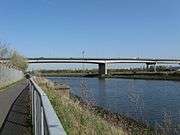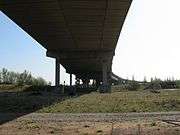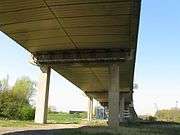Tees Viaduct
| Tees Viaduct | |
|---|---|
|
(A19) Tees Viaduct from Maze Park's viewing hill | |
| Coordinates | 54°34′4.08″N 1°16′4.44″W / 54.5678000°N 1.2679000°W |
| Carries | A19 road |
| Crosses | River Tees, Teesdale Way, Thornaby Middlesbrough railway line, B6541 and A66 roads and Lustrum Beck |
| Locale | Middlesbrough, England, UK |
| Official name | A19 Tees Viaduct |
| Owner | Highways Agency |
| Maintained by | Autolink Concessionaires (A19) Limited (1997-2027) |
| Preceded by | Tees Barrage |
| Followed by | Tees Newport Bridge |
| Characteristics | |
| Design | Slab and Girder |
| Material | Steel plate girders and composite concrete deck on reinforced concrete piers |
| Total length | 2.9 km, spanning 1.95 km |
| Longest span | 117 metres (384 ft) |
| No. of spans | 68 |
| Piers in water | none |
| History | |
| Construction start | 1973 |
| Construction end | 1975 |
| Opened | November 1975 |
| Statistics | |
| Daily traffic | 70,000 vehicles per day |
The A19 Tees Viaduct or Tees Flyover is a six-lane dual carriageway road bridge in the North East of England carrying the main A19 trunk road north-south across the River Tees. It is situated between Middlesbrough and borough of Stockton-on-Tees just north of the A19's interchange with the A66 trunk road. The Teesdale Way long-distance footpath, the Tees Valley Line, the B6541 (Old A66/A67, Stockton Road) and the A66 pass under the bridge on the southern bank of the Tees.
Design
The viaduct is a beam or girder bridge. It has reinforced concrete piers and pier bends supporting steel-plate girder beams and a composite deck with some 200 moving parts.[1] The viaduct is 2.9 km long[2] and 1.95 km between abutments[3] and was at the time the largest such bridge in the British Isles.[4][5] It has 68 spans on the main north south route—the largest span being that over the river at 117 m.
The bridge was designed with sufficient clearance to allow ships to pass, although the port of Stockton-on-Tees up-river was virtually redundant by then.[6][7] Since the Tees Newport Bridge had its lifting deck permanently fixed in the down position in 1990, large shipping can no longer reach the Tees viaduct, further reducing the need for such a high structure.
Construction
The bridge was built between 1973 and 1975[6] encompassing the 'Three-Day Week' and that may account for some of its subsequent problems.
Operation
The bridge has had problems with corrosion since the it was opened and repairs have been necessary at times.[6] Expansion joints cracked allowing de-icing salts to wash from the bridge carriageway into the piers, cross beams and columns giving rise to extensive chloride attack. It was then decided the best solution was the complete demolition and reconstruction of most of the piers and repair of others.[8][9][10][11] From 1988 the underside of the bridge deck was enclosed with a steel and GRP panelling structure to protect the primary structure from the effects of weather and to allow safe and easy inspection and maintenance.[5][6][12]
The bridge now carries some 70,000 vehicles a day[13] and there are concerns that the capacity of the road is being exceeded at peak times[14] Because of this CCTV cameras were installed on the bridge to record incident related congestion and respond more quickly.[15] A detailed principal inspection report in 2006 concluded that the Tees Viaduct overall is in fair condition.
|
References
- ↑ "How Tees Valley spans the world". Evening Gazette. 21 October 2003. Archived from the original on 16 July 2011. Retrieved 18 November 2008.
- ↑ "A19 Tees Viaduct". Bridges on the Tyne. Retrieved 29 October 2009.
- ↑ ???
- ↑ "River Tees Crossings". Three Rivers Cycle Route. Archived from the original on 19 August 2008. Retrieved 18 November 2008.
- 1 2 Hollaway, Leonard (1990). Polymers and Polymer Composites in Construction. Thomas Telford. Retrieved 18 November 2008.
- 1 2 3 4 "A19 Tees Viaduct". Bridges on the Tyne. Retrieved 18 November 2008.
- ↑ Chris Kenyon. "A Trip up the Tees". Tees Rowing Club. Archived from the original on 9 October 2008. Retrieved 18 November 2008.
- ↑ John Brian Newman, Ban Seng Choo. Advanced Concrete Technology. BH. Retrieved 18 November 2008.
- ↑ "Bridge of Sighs". ContractJournal.com. 18 May 1995. Retrieved 18 November 2008.
- ↑ "Teesside Viaduct-Helping To Strengthen The A19". Lindapter. Archived from the original on 10 December 2008. Retrieved 18 November 2008.
- ↑ D.A. Kimberley. Repair Rejuvenation and Enhancement of Concrete: Tees Viaduct Chloride Extraction Trial. Retrieved 18 November 2008.
- ↑ Chris Burgoyne. "I.Struct.E. Study Group on Advanced Composites". University of Cambridge. Archived from the original on 12 January 2006. Retrieved 18 November 2008.
- ↑ "Changes slowed traffic". HighBeam Research. Retrieved 13 August 2008.
- ↑ "Draft Darlington Local Transport Plan 2006–2011" (PDF). Retrieved 13 August 2008.
- ↑ Dr Stephen Ladyman (22 May 2007). "www.parliament.uk Publications and Records Transport". Parliament. Retrieved 18 November 2008.





